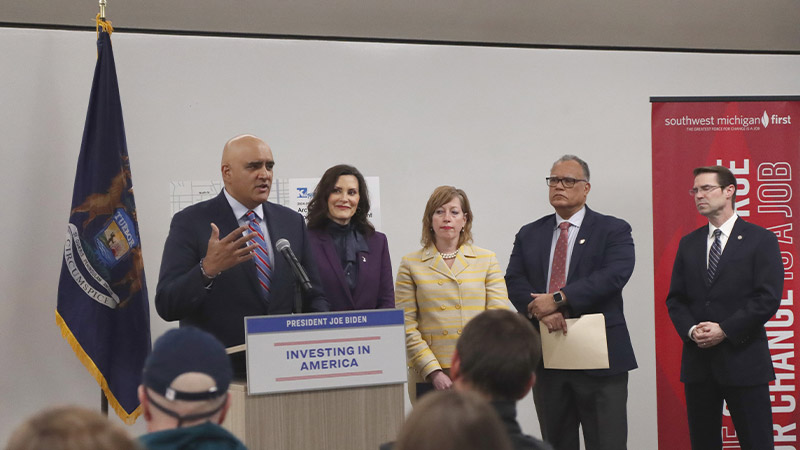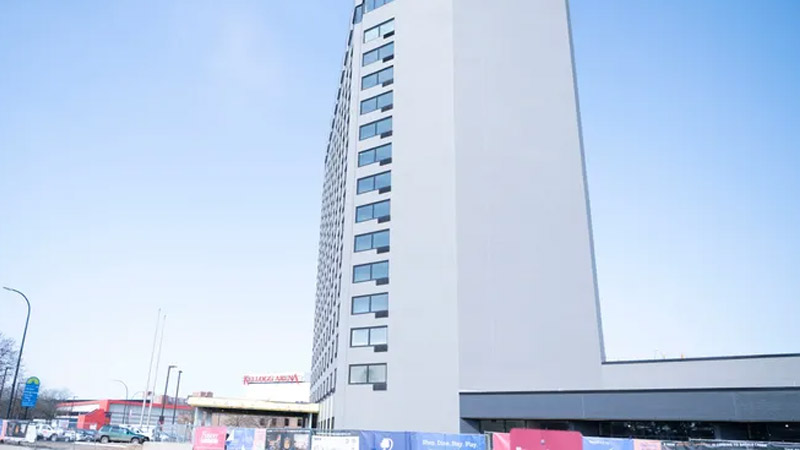During the final weeks of 2020, Kalamazoo was riding high from headlines around the globe touting the achievements from our neck of the woods in producing the first COVID-19 vaccine approved in the U.S. for widespread use. As the way things seem to go with everything these days, there was a “Debbie Downer” around the corner. In this case, Bloomberg and its piece, ”Worst Spot for U.S. Brain Drain Gets Hope as Covid Vaccine Hub,” chose to fill that negative role by citing our city–Kalamazoo, Michigan–as the bottom dweller on its 2020 Brain Drain Index for being guilty of population loss.
Before we offer some insight into what the real data says, we hope the article riled you up as much as it did us. For some reason, the authors seemed to think our economy stopped cold after the year 2009. With Kalamazoo county’s November 2020 unemployment sitting at 4.0 percent, which is well below the area’s historical 5.2 percent average, we are scratching our heads as to how we are still considered to be living in an “old factory town” and that this achievement during the pandemic is defined as being in the midst of a “slow comeback from auto-plant closures in spring.” Since we are a glass half full kind of crowd here, we will point out that they held hope for us with the increased manpower producing the vaccine will require, being a place where folks can find less friction in their lives, and our slowing COVID-19 infection rate.
Before we offer our side of the story and point out the flaws in Bloomberg’s argument, we would like to thank the researchers at the W.E. Upjohn Institute for Employment Research and WOOD-TV team who have already called out the main error in the ranking. As the institute’s president Michael Horrigan says, “They were comparing apples and oranges.” What he means is, between the years 2015 and 2019, the American Community Survey changed its definition of the Kalamazoo-Portage Metropolitan Statistical Area (MSA)–areas in Van Buren county that were previously included in the MSA were removed.
So, are you ready to dive in deeper into the data? We are.
Metropolitan Statistical Area Definitions
Between 2015 to 2019, which is inclusive of the time period evaluated in this research piece, the metropolitan statistical area (MSA) definition was altered, affecting the scope of Kalamazoo-Portage, MI MSA. The 2015 definition of our MSA included Van Buren county, whereas the 2019 MSA definition omits Van Buren county. This contraction of our MSA is a large factor in our population decline, as well as our loss of white-collar jobs. Even though Van Buren county tends rural, there are clusters within the county such as Mattawan that are highly educated and would impact this analysis. Thanks to the Charles River Lab facility, Mattawan has a location quotient of 12.01 for life, physical, and social science occupations (i.e., Mattawan has 12.01 times the national average of employees involved in life science, physical science, and social science) and that was a category included in their white-collar analysis.[1] This also dramatically impacts the “Science and Engineering Degree Holders” metric in Bloomberg’s analysis. Thus, the dramatic drop in population, white-collar workers, STEM job pay, and Science and Engineering degree holders, as a function of metropolitan statistical area from 2015 to 2019, is highly misleading.
When looking at Kalamazoo county alone–a stable metric over time–the population has grown from 247,246 in 2010 to 261,573 in 2018, or an average of 0.71 percent annualized growth over the eight years.[2] Likewise, over time, the percentage of education attainment (i.e., the proportion of the population with X degree) has only grown over the past eight years.
According to the methodology at the end of this work: “Total white-collar jobs approximated by taking the headcount of civilian FTYR [full-time, year-round workers holding] jobs in the broad category of management, business, science, and arts, which includes sub-categories such as finance, education, legal, healthcare, computer and engineering.”
These broad categories are consistent with Standard Occupation Codes (SOCs) from the Bureau of Labor Statistics, which are the gold standard of evaluating jobs based on title and area of expertise.[3] While we are unable to confirm the SOCs that Bloomberg pulled, we can, with a relative sense of certainty, suggest that they used the following SOCs for this review: 11-0000 (Management Occupations), 13-0000 (Business and Financial Operations Occupations), 15-0000 (Computer and Mathematical Occupations), 17-0000 (Architecture and Engineering Occupations), 19-0000 (Life, Physical, and Social Science Occupations), 23-0000 (Legal Occupations), a subset of 25-0000 (Educational Instruction and Library Occupations), 27-0000 (Arts, Design, Entertainment, Sports, and Media Occupations), and a subset of 29-0000 (Healthcare Practitioners and Technical Occupations).
It is unlikely that this analysis included 41-0000 (Sales and Related Occupations) or 43-0000 (Office and Administrative Support Occupations). Many of these occupations are not traditional white-collar workers, but there is a high probability that sales staff at our region’s large employers were omitted from this analysis, and those are highly educated white-collar professions. Since our labor market has relatively high proportions of production and back office workers, the degree-holding employees associated with those industries (technical back office workers, technical sales, etc.) were likely not included.
Educational Attainment
Unfortunately, there is no question that our region struggles to retain the graduates coming out of our colleges and universities to bigger cities. However, there is little data within the county to suggest that we are losing middle age educated workers. There is only evidence to suggest we are losing young, educated workers out of college, and retired educated workers to the South.
Kalamazoo-Portage, MI MSA remains 5.6 percentage points above Michigan’s average bachelor’s degree attainment. In Kalamazoo-Portage, MI MSA, 11.1 percent of the population has an associate degree, 24.5 percent of the population has a bachelor’s degree, and 14.8 percent of the population has a postgraduate degree.[4] Michigan, comparatively, is lower on all metrics: Associate degree attainment (10.3 percent), bachelor’s degree attainment (18.9 percent), and postgraduate degree attainment (11.2 percent). Similarly, Kalamazoo-Portage, MI MSA is also above the national average on all metrics: Associate degree attainment (9.1 percent), bachelor’s degree attainment (20.8 percent), postgraduate degree attainment (12.1 percent).[5]
The proportion of the population in Kalamazoo county with degrees has only increased over the past eight years. In 2010, only 9.0 percent of the county’s population had an associate degree–now it is 11.1 percent. Only 22.6 percent of the population held a bachelor’s degree in 2010, but that is now 24.5 percent. Likewise, 12.6 percent of the population held a postgraduate degree in 2010, and that figure is now 14.8 percent. We have been equally effective at reducing the percentage of the population without a high school diploma–from 6.6 percent in 2010 to 5.9 percent in 2018. Additionally, Kalamazoo-Portage, MI MSA has nearly half the population with no high school diploma, at 5.9 percent of the population, compared to the national average of 11.2 percent.[6]
Migratory Trends and Age Distributions
Even though at a surface view this report looks like it dramatically impacts the quality of the available labor force in Kalamazoo-Portage, MI MSA, that may be misleading as well. Setting aside the limitations to this piece regarding the metropolitan statistical area definition change, the true loss of educated individuals from the region is likely a retired cohort.
According to the Michigan Department of Health and Human Services, the 2018 replacement rate in Michigan was 1.7, indicating that for every couple (2.0 persons), there are 1.7 persons being born, which is a predictor of population decline and population aging.[7] From 2010 to 2018, the average age in the United States grew by 1.0 year–from 36.9 to 37.9. Conversely, in Kalamazoo, the average age grew much more slowly over that time period by only 0.3 years–from 33.9 to 34.2.[8] When our replacement rate is below 2.0, yet our average age is growing much more slowly than national average, it is likely that the elderly population is dying or leaving the state at a higher rate.
This, coupled with state-to-state migration tends, likely suggests that the older population in Michigan is leaving the state. In 2018, Michigan lost 152,605 residents to other states (while it gained 139,276 from other states). A plurality of that loss of Michigan residents–20,852 (13.66 percent)–went to Florida.[9] While the Census Bureau does not release age distribution of those state migratory trends, nor do they release migration trends by MSA, based on historical data we can make a reasonably certain assumption that, due to our stagnated age growth relative to the United States, it is primarily retired citizens leaving Michigan for Florida. Retired citizens with the ability for mobility have a higher propensity to be educated, and thus would help explain Kalamazoo’s loss of educated population. Thus, since the loss of educated persons is likely retired persons, this would not impact our region’s educated labor force.
___________________________________________
Sources:
[1] Chmura Analytics JobsEQ, 2Q2020
[2] Chmura Analytics JobsEQ, Census 2018
[3] Bureau of Labor Statistics, Standard Occupational Codes. Sourced.
[4] Chmura Analytics JobsEQ, Census 2018
[5] Ibid.
[6] Ibid.
[7] Michigan Department of Health and Human Services, 2018. Sourced.
[8] Chmura Analytics JobsEQ, Census 2018
[9] Census Bureau State-to-State Migration Flows, 2018. Sourced.




